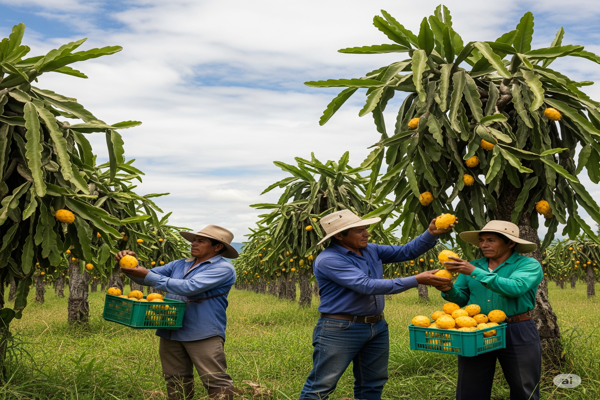The Red dragon fruit (pitahaya) market is undergoing a period of pronounced volatility and opportunity, shaped by sharp price swings, climate adversity, and bold strategic pivots by Ecuadorian exporters. While Ecuador’s 2025 yellow pitahaya season showcased remarkable stability, the red variety experienced dramatic pricing fluctuations—rising as high as $35/box before plummeting to $10/box as competing fruit from Florida and Central America saturated markets. This turbulence not only underscored the sector’s sensitivity to both climate irregularities and global competition, but also prompted Ecuador’s leading exporters to fast-track investments in technology, risk mitigation, and product diversification.
Amid Ecuador’s wettest winter in a decade and shortened production cycles, companies like Ecuaexotics are navigating future risks through crop diversification, targeting rambutan and mangosteen as new frontiers, and intensifying their push into Asian markets. Despite promising gains—especially in China—the Red dragon market faces mounting competition from Peru, Spain, Egypt, Vietnam, and China itself. Looking forward, ongoing climate change, Asian demand dynamics, and innovation investment are set to define the fortunes of this vibrant export industry.
📈 Prices: Red Dragon Fruit at a Glance
| Product |
Origin |
Location |
Delivery Terms |
Latest Price (EUR) |
Previous Price (EUR) |
Update Date |
Weekly Change (%) |
Market Sentiment |
| Red Dragon Dried |
Vietnam |
Hanoi |
FOB |
7.15 |
7.15 |
2025-08-23 |
0% |
Stable |
🌍 Supply & Demand Landscape
- Yellow pitahaya remains a stable revenue core for Ecuador, with prices between $10–12/box.
- Red pitahaya faces dual pressure: sharp price swings and shorter production cycles caused by erratic weather.
- Global competition intensifies as Peru, Spain, Egypt, Vietnam, and China expand acreage.
- Exporters are diversifying, focusing on rambutan (R134 variety, 36-ha projects with phased harvests starting November 2025) and mangosteen (40-ha project, yields expected by 2028).
- Asia, especially China, is a strategic focus—yet faces challenges from growing internal Chinese supply.
📊 Fundamentals & Production Snapshot
- Production Cycle: Reduced to 4–5 weeks in 2025 vs historical 8–10 weeks, reducing volumes but potentially increasing quality with new tech investments.
- Technification: Washing, drying, and waxing automation to improve post-harvest quality and cut costs.
- Inventories: Ecuador’s exportable surplus likely declining due to climate-damaged output, while Central America fills gaps during Ecuador’s off cycles.
- Expanding Export Markets: Besides traditional outlets (U.S., Canada, Europe), Ecuador’s recent entry into China offers upside—pending U.S. phytosanitary protocols to unlock further growth.
⛅ Weather Outlook & Yield Risk Analysis
- 2025 Outlook: Continues to be impacted by anomalous rainfall and temperature swings, with the wettest winter in a decade (climate data June–August 2025 indicates 20% above-normal rainfall, occasional heat spikes at 35–37°C, and sporadic cool spells).
- Effect on yields: Shorter crop cycles and potential disease risk may limit export volumes this season. Global climate models suggest this erratic pattern persists into Q4 2025.
- Competitive Regions: Central America expecting near-average yields; Vietnam sees rising acreage but faces uncertainty from monsoon variability.
🌏 Global Production & Stock Comparison
| Country |
2025 Est. Production (mt) |
Change YOY |
Export Focus |
| Ecuador |
~12,000 |
-15% |
Yellow/Red pitahaya, new Asia focus |
| Vietnam |
30,000+ |
+5% |
Dried, Fresh, Strong Asian/EU markets |
| Peru |
8,500 |
+8% |
Fresh, expanding in Europe/Asia |
| China |
115,000 |
+7% |
Bulk for domestic, rising export |
📆 Market Forecast & Trading Outlook
- Supply tightness in Ecuador likely to persist until Q4 as yields recover from weather shocks.
- Monitor Asian market demand, especially China’s internal harvest cycles and regulatory changes.
- Watch for potential spot price volatility as Central American crops come online—short-term downward price risk if surpluses emerge.
- Long-term upside remains for exporters investing in value-add and market diversification (e.g., dried formats, ready-to-eat packs).
- Trading Recommendations:
- Buyers: Secure contracts early for premium Ecuadorian fruit; evaluate Vietnamese supply for price hedging.
- Exporters: Position for Asia; build resilience into supply chain management and consider collaborative promotion at global fruit expos.
- Investors: Monitor progress of rambutan and mangosteen diversification—potential for early-mover advantage by 2026–2028.
🔮 3-Day Regional Price Forecast (CBOT/Euronext Not Applicable – Specialty Crop)
| Date |
Region |
Product |
Expected Price Range (EUR) |
Sentiment |
| 2025-08-24 |
Vietnam FOB Hanoi |
Red dragon dried |
7.10 – 7.20 |
Stable |
| 2025-08-25 |
Vietnam FOB Hanoi |
Red dragon dried |
7.05 – 7.20 |
Slightly Soft |
| 2025-08-26 |
Vietnam FOB Hanoi |
Red dragon dried |
7.05 – 7.20 |
Slightly Soft |



